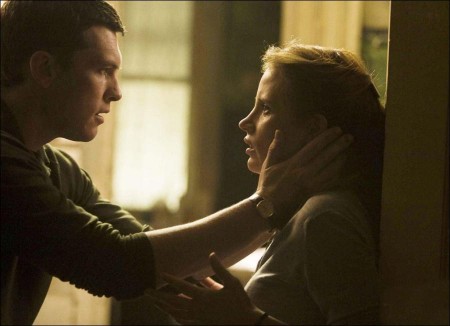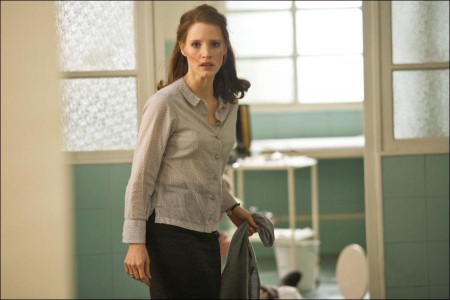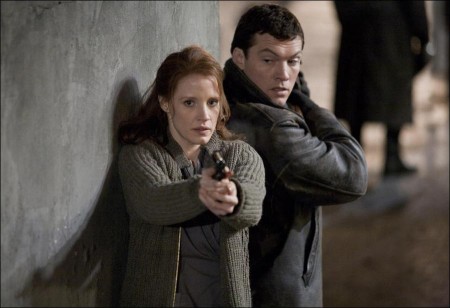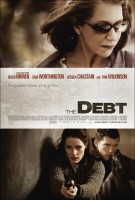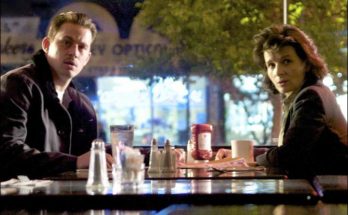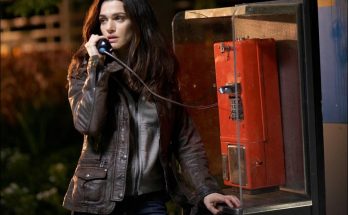Taglines: Every secret comes with a price.
The espionage thriller begins in 1997, as shocking news reaches retired Mossad secret agents Rachel (Helen Mirren) and Stefan (Tom Wilkinson) about their former colleague David (Ciarán Hinds). All three have been venerated for decades by their country because of the mission that they undertook back in 1966, when the trio (portrayed, respectively, by Jessica Chastain, Marton Csokas, and Sam Worthington) tracked down Nazi war criminal Vogel (Jesper Christensen) in East Berlin. At great risk, and at considerable personal cost, the team’s mission was accomplished – or was it? The suspense builds in and across two different time periods, with startling action and surprising revelations.
This is a period spy drama with some action elements. Sam Worthington has a distinctly supporting role to the lead role, which is split between Jessica Chastain and Helen Mirren. Older adults are the target. Violence, language, and heavy subject matter make the film inappropriate for children.
About the Production
After the Israeli feature film Ha-Hov [The Debt], directed by Assaf Bernstein and produced by Eitan Evan, opened in 2007, the thriller received four nominations for Israel’s Academy Awards equivalent. Evan credits the film’s having been sold for distribution to countries beyond Israel to “its original story, combined with the thriller plot about Mossad agents on a mission. Mossad is an institution, one of the best in the world for espionage and intelligence, and the film had an authenticity to it with regard to them.”
Producer Eduardo Rossoff took note of the film as being ideal for an English language remake, tied to its unique two-tiered storyline revolving around 30-yearold secrets coming to light, and brought Ha-Hov to the attention of producer Kris Thykier.
Thykier was instantly intrigued. He recalls, “It was a spectacular story, and brilliantly acted. I did feel that there was an opportunity for a little more complexity and scale; I saw the potential of making a smart thriller that would be relevant to – and entertaining for – a world audience.”
After viewing the film, Thykier’s producing partner Matthew Vaughn agreed. As Evan spoke with Thykier by phone and then in person to finalize the new project, Vaughn started work on the script adaptation for the remake with his screenwriting partner Jane Goldman.
Six months later, the producers presented the script to Oscar-nominated director John Madden. He found the screenplay to be “offering a visceral narrative in which both the emotional and moral stakes are very high, coupled with depth in the characterizations. One’s engagement in the material deepens as the story becomes more complex and begins to exercise more of a grip. I was transfixed. “I hadn’t seen the Israeli film when I read the script. I felt I needed to watch it – and I’m glad I did, but then I didn’t look at it again.”
Thykier says, “We were thrilled that John was interested, and we quickly started preparing the project with him. He is a genuine renaissance man, totally involved and committed from the start to making the material work as a movie.”
Madden began honing the script with screenwriter Peter Straughan. The director notes, “The level of narrative development in the material is unusual in that the audience is constantly kept guessing about just what’s going on – and we wanted to heighten that.
“Assaf Bernstein and Ido Rosenblum’s script for the original film had an underlying foundation and structure that was solid, and Matthew and Jane had already developed the story in some interesting ways. But as Peter and I began to work on the story, we found new directions emerging. And the thematic emphasis of the film started to shift.”
Evan agrees, noting that “the new film involves the past much more than the present, and there is more action. The Debt also delves deeper into the psychology of the Israeli characters.”
Thykier observes, “With the script’s intelligence, and depth of character, we now had what I saw as a return to the 1970s thrillers that I had grown up on, like Three Days of the Condor and Marathon Man.”
With such actor-driven thrillers in mind, Madden knew that the cast “would be central to The Debt. Inevitably these characters would be close to us, often very close. We watch them making a choice, see it ripple through a lifetime, and witness its profound effects.”
Nowhere was this more important than with the lead character of Rachel Singer. The filmmakers needed an actress of a certain age to embody Rachel in 1997. She would have to be someone capable of conveying the uncertainty that haunts her, and embracing the physical challenges. With those prerequisites, Thykier states, “Who else could it be but Helen Mirren? We’d always thought of her for this role.”
Madden had previously directed Mirren in one of her celebrated Prime Suspect telefilms. He notes, “That was a fantastic experience for me. Helen is an actress at the top of her game, and she likes to test herself. She is fearless. Helen responded immediately to the challenge of this material.
“Here’s a role which required her to intimate the wounds and the corrosive effect of events suppressed over 30 years. The tension and pain of a decision made long ago are evident; she literally bears a scar from what happened back then. All this has to come across amidst the pace and excitement of a thriller.”
Mirren comments, “Aside from wanting to work with John again and the fact that this was a good thriller story, I was interested in exploring the notion of how every action you take in life has a result, a consequence, and sooner or later you are going to have to face up to it.”
“Having learned to live with compromise, Rachel is finally realizing that it doesn’t always work. She is not a person who reveals much to anyone, not even to the daughter who has written a book about her and her colleagues. Rachel has buried her true emotions and has existed for many years on a superficial level, not confronting the depth of her real feelings about things. She finds she has to do that, and much more.”
For that “much more,” Mirren rose to the occasion, learning the basic moves of krav maga, the renowned tactical defense skill that is rooted in hand-to-hand combat. Krav maga is the official self-defense system of the Israeli Defense Forces.
However, Mirren points out that “at this point in her life, Rachel is retired and hasn’t fought in some years, so I wanted to keep that realistic. While she was trained in krav maga, that was a long time ago. So when she is called upon to defend herself again, she’s far from a credible fighter.”
With their latter-day Rachel set, the filmmakers turned to casting the younger incarnation. Madden wanted to “not to be enslaved by the necessity to find a lookalike actress. “But then we did find the perfect actress, who has an extraordinary physical affinity with Helen.”
Rising star Jessica Chastain was recommended to Madden “by an agent I trust, someone who didn’t even represent her.” Chastain had recently filmed The Tree of Life for director Terrence Malick, who when phoned by Madden offered an overwhelmingly positive recommendation. “He was happy to talk forever about her,” Madden says.
Chastain remarks, “When I first read the script, I didn’t even see it as a thriller. To me, it was a drama and a love story. It was so good that I felt, ‘I have to be in this movie.’
“I wanted to work with John Madden because he works both in theater and film, and that’s what I like to do as well.”
The actress reveals, “I do a lot of research, and I went into my first meeting with John very prepared. I had found out that Helen Mirren and I are the same height, so I said, ‘Just to throw it out there…’”
Impressing the filmmakers with her grasp of the character, Chastain got the plum part. “She is magnetic to watch,” says Madden. “She elicits an emotional involvement from the viewer. There’s no equivocation in the choices she makes, and emotionally she is absolutely clear.
“Helen has exactly that same quality. You can see the tiniest change of mood flutter across her face. That kind of transparency is rare, and it’s a gift. The baton of Rachel passes effortlessly from one actress to the other.”
Unable to share the screen, “the two Rachels” instead met to compare notes well before filming began. Mirren and Chastain read scenes together and worked out shared characteristics that would resonate within the film.
Chastain remembers, “Helen and I got together in London with [production dialogue coach] Joan Washington to work on Rachel’s voice. We also discussed gestures Rachel would make.”
Mirren adds, “We collaborated with John, and with the costume and hair and make-up departments as well. Between the two of us, Jessica and I came to a consensus about who we wanted this one person to be.
“In 1997, she is hidden, polished and reserved. But the younger Rachel is a very different person…”
Chastain notes, “Helen asked me about what I thought Rachel’s family history might be, and we talked about where perhaps Rachel would end up; it’s in the script, of course, but this way we could see that we were on the same journey.”
In 1965-1966, Rachel is the youngest member of the trio of Mossad agents sent to capture the war criminal Vogel. Thykier notes, “She has no experience as a field agent up to that point, and that has a significant effect on the way the story unfolds.”
The actress herself lacked experience in one key area; Chastain admits, “I could not be more different from a Mossad agent. Before The Debt, I had no idea how to even throw a punch; I had never been in a fight in my life.”
Accordingly, she trained with a krav maga expert four times a week for four months in Los Angeles before coming to London for rehearsal with her fellow actors. As a result, “she does all of her own fighting and stunts in the film,” Madden reveals.
Chastain reports, “I packed on a little bit of muscle, and, considering that I am a pacifist, I really enjoyed filming the fight scenes.”
Chastain’s on- and off-screen colleagues include Sam Worthington, who portrays David, the idealistic but conflicted Mossad agent who is drawn to Rachel almost immediately. Long before his star-making role in the record-breaking Avatar, Madden had spotted Worthington in the Australian independent feature Somersault. “Sam has this attractive, masculine, powerful presence but he also has a vulnerability,” comments the director. “I felt that he could capture the contrasts of David.”
Worthington was intrigued by the character’s moral conviction and emotional burdens. “David is a man who lost his entire family in the Holocaust, and is consistently questioning his own worth,” the actor states. “He dedicates himself to being an effective Mossad agent, as he feels he has the weight of a nation on him. With this mission, David’s idealism becomes at risk and he doesn’t know how to handle that.
“John pitched me the story while visiting me on a movie set, and he completely sold me on his vision of these three people who confront a monster but are then haunted for decades. This makes for quite a thriller, but the core of The Debt is the notion of living with repercussions for decades.”
To play Stephan, the driven leader of the unit, the filmmakers cast Marton Csokas, whom Madden praises as “brilliant. He’s got this louche sexuality about him, and he brings a sense of danger and a neurotic energy to Stephan that creates a dramatic tension amongst the trio. It’s Stephan’s choices that drive the story.”
Csokas sees his character as being “a potent force, and fervent about bringing the Surgeon of Birkenau to justice. During the course of the story, he is tested by the claustrophobic situation that the agents find themselves in; it’s one born of ambition and passion. For me, Stephan was a juicy role in the exciting context of a resonant thriller.
“All of the characters in The Debt have their ambiguities; no one is black-and-white. They have their weaknesses and their strengths, they know both victory and failure.”
Madden felt that with these two men cast opposite Chastain, the story took on even more potential. He notes, “The next step was to develop the chemistry among them. On this film, beyond working on the text and doing some improvisation, we had to rehearse the unique physical component.”
So it was that, like Chastain, Csokas and Worthington underwent training for the krav maga sequences. The three actors trained together for nearly two weeks. Csokas offers, “Neither Sam nor myself became experts by any stretch of the imagination, so we looked after each other – and had our little codes to make sure neither of us got hurt.”
Fight/stunt coordinator Julian Spencer notes, “Krav maga moves are so fast that we had to work on slowing them down a little bit for the camera. Otherwise, the viewer would be left wondering, ‘What happened?’
“John Madden would allow me to step in and give my five minutes’ worth of notes to the actors, and then he would bring it all to life with them, incorporating the blocking.”
“That group discipline was a tremendous benefit,” says Madden. “They could hang out, while also getting in shape and up to speed for their fighting scenes together.”
Chastain says, “We worked as a team even when we were not on-set. In the car going to or from the set, we would be discussing scenes. We’d give each other ideas, and ask each other questions. Sam and Marton made me a better actor because they both work so hard. But they also have a great sense of play so, surprisingly, given the heavy subject matter, we laughed a lot – off the set.”
“They became very close,” Thykier says. “All three were full of energy, focus, and enthusiasm. Whether it was krav maga training or rehearsing dialogue to hone their accents, their shared work ethic drew them together.”
The shared history that binds David and Stephan to Rachel was borne out in the casting of Ciarán Hinds and Tom Wilkinson, both of whom had worked before with Helen Mirren. “This is in fact the sixth time that Ciarán has worked with Helen,” comments Madden. “They truly do have a long history together, and in this particular movie they bring a poignancy to their characters’ relationship.”
Hinds muses, “I seem to ambush Helen every five years or so. It’s enormously pleasing, and the experience is always compelling – for me, at any rate!
“I considered it a great honor to be in the company of Helen and Tom, and I’d heard how wonderful John was to work with, so I was thrilled when he asked me to play this role. He’s a great director.”
Mirren comments, “For the scenes that we share in The Debt, it was a great advantage to have worked with these two actors before.”
Approached to play the older Stephan, two-time Academy Award nominee Tom Wilkinson was drawn to the project by the prospect of reuniting not only with Mirren, whom he calls “a wonderful person,” but also with Madden, for whom he had starred in the Oscar-winning Shakespeare in Love. The actor remarks, “John’s very good with actors, but he also has a strong technical side – with the camera and the editing – and he always works hard on the script.
“With regard to this story, what interested me was, can one be redeemed after the endless duplicity of being a secret agent? There’s an element of a movie I did a couple of years ago, Michael Clayton, in The Debt, and also of Sidney Lumet’s thrillers. When everything you do is accompanied by spin, all the common decencies we take for granted in our lives – all the morals, the ethics – are completely eroded away. So Stephan’s relationship with Rachel has gone distant – but he manipulates her anew, in a game with destiny that could be fatal.”
Wilkinson adds, “Marton and I spoke by phone about our character and where the script takes him, and we agreed that Marton would proceed with how he was going to play Stephan; since he was filming first, I later took a look at his scenes and worked further on the character with John. There was a certain continuity I was careful not to break.”
Worthington had also set his take on David. He says, “David is a quiet, controlled man who starts to explode and then he can’t put the lid back on. Actor to actor, I knew I could trust Ciarán to take it from there – whether he watched rushes of my scenes or not.”
Hinds says, “I did make sure to see a couple of scenes that Sam had completed. Of the two men in the equation, David is the more shy, more guarded one and he feels very uneasy once the mission is over. I concentrated on finding the soul, the essence of David some thirty years later, with his having been plagued by self-doubt all that time.”
To play “the Surgeon of Birkenau,” an almost unimaginable monster who has killed or maimed thousands, Madden sought a performer who wouldn’t ooze “evil on tap. We wanted an actor with whom the audience would not necessarily be familiar, about whom they could not make instant judgments. An actor of great power and subtlety. He also had to be fluent in German and English.”
Copenhagen-born Jesper Christensen met all the criteria to play Dieter Vogel. The actor was coming off of back-to-back turns as James Bond antagonist Mr. White in Casino Royale and Quantum of Solace, but Christensen saw The Debt as “a thinking man’s thriller with multiple layers. When I read the script, I wanted to see what happened next – and I didn’t see what was coming.”
Madden in turn was taken straight away by Christensen’s “craggy, intriguing face that is somehow ageless; he can look either 50 or 80, as needed. “What Jesper also brought to the part was the ability to be not instantly or even consistently villainous but, rather, exhibit a paradoxical charm and tenderness. Making Vogel rounded was crucial; this is a man who has made accommodations for his deeds but over the course of the story runs a gamut of emotions.”
Christensen adds, “The man is so terrible that I didn’t have to make the audience any more disgusted with him than they already are. What I needed to do was to bring out his dimensions, the humanity that he does possess, and the rationalizations that he has built around his past.”
In their first meeting, Christensen spent hours with Madden reading through the script and working out a number of scenes, “displaying the kind of fearlessness and willingness that he went on displaying all the way through the making of the film,” comments the director. “Like Jessica, Jesper did all his own fighting and stunts, with spectacular results.
“When we were shooting, he endured the safe house scenes – where he would stay tethered for hours and hours on end – with tremendous grace. He would even do scenes where other actors would have said, ‘You don’t need me for this shot.’ At one point, I wrenched my own shoulder pulling him up from the floor!” Christensen confides, “I would rather not do stunts myself, because I don’t recover that quickly any more. But, it’s my technique.”
Aside from utilizing the physical challenges to advance his character, Christensen concentrated on how “when the three agents are holed up in the safe house with Vogel, it becomes impossible for them to dehumanize him any longer. Before that, he was just a monster to them, someone who has done the most awful things; suddenly, he’s there with them and they are responsible for feeding and bathing him. So the moral stakes rise; now how they will treat this man?
“Vogel’s nature emerges as he constantly tests them, and cleverly works his way into the consciences of each member of the trio. As an actor, it was thrilling to play.”
Two weeks of intense rehearsals were held at Ealing Studios; the setting of the safe house/apartment on a crumbling East Berlin block was built by production designer Jim Clay (BAFTA Award winner for Children of Men) and his department as a 360-degree environment, carefully following the script’s specifications to create a genuinely claustrophobic atmosphere for Christensen to interact with Chastain, Worthington, and Csokas. Minor adjustments were made with regard to blocking needs as well as for the characters being impacted by their environment.
Principal photography commenced in chronological order – with the safe house scenes filmed over three weeks – so that the actors could maintain the momentum from the rehearsals and better play out the festering tension between captors and captive.
Worthington notes, “It was our good fortune to be shooting in sequence – a great luxury to have in making a movie – and not having to suspend disbelief, given the tangible nature of the set.”
“It wasn’t unlike working in the theater,” says Csokas. “We would go into the studio and rehearse on the same sets every day. When the crew got in there with the lights and the cameras, it became more claustrophobic.”
“By the end, I wanted to kick the place down,” admits Worthington. “Just like the character, I didn’t want to be there any more.”
Chastain reflects, “I was kind of hoping that I wouldn’t like Jesper when I first met him in rehearsals; I even tried not to get to know him that well. But I found him to be absolutely lovely, and I thought, ‘Well, the scenes are going to be impossible to shoot now, because I really like this guy.’
“But he’s such a good actor that as soon as we got onto the safe house set, I just hated him; hated that he was there, tied to that radiator. I just wanted to get away. I would leave the set at night exhausted.”
Clay reveals, “The safe house set was inspired by a series of Francis Bacon paintings showing his lover’s final desperate moments. I had happened to see these at the Tate gallery – just after John Madden had sent me the script. It struck me that these paintings had a real relevance to Vogel; he is captured and tied up in a room, facing the moment of his truth and the abyss of mortality. We tried to create that atmosphere on the set, what with the dark walls and a black frame around the lone figure of Vogel, and [director of photography] Ben Davis conveyed that.
“We also tried to layer in a back story for the apartment itself, to give it color on the walls which suggested that the apartment once had happier days and a purpose, being occupied by young art students.”
“You could have moved into the apartment,” marvels Thykier. “You’d look behind the doors and find what would be there; no detail was left to chance. As soon as everyone –cast and crew – saw what Jim and his department were building, the bar was set.”
The verisimilitude of the safe house set was enhanced by Clay’s team’s use of actual materials; distressed door and window frames, floors and tiles – much of which had been found at demolition sites visited as part of location scouting in Budapest. Clay notes, “My set decorator, John Bush, and I sought out all those dressing details, and shipped them back to London.
“We didn’t have to paint those elements. They had the natural decay of time, which lends an element of reality that is virtually impossible for even a skilled crew to achieve.”
The crumbling architecture in and around the set also underscores the corrosive effects of the lie that pervades The Debt. Worthington notes, “It certainly informed my performance. It was this little world that our characters are forced into with Vogel.
“We had to come in prepared. As a director, John shoots fast and trusts the actors, but he will push you in the right direction towards what he wants.”
The production then moved to the previously scouted Budapest, which had been judged capable of providing the textured background that would ably suggest East Berlin in the 1960s. Arriving in the city at the end of a particularly harsh winter, the production was able to take advantage of a cold and dampness that pervaded exteriors and kept the streets clearer than expected during daylight hours. The cast and crew’s endurance was tested by the long and freezing night shoots.
Most of the desired locations were grouped around one central area; these included the safe house exteriors, Vogel’s clinic, and a re-created Berlin Wall. Clay hastens to clarify that the latter “is not the iconic Berlin Wall that everyone came to know, but instead the block-and-concrete that was rather hastily thrown up during the period in the 1960s in which this part of the story is set. This was done in the areas where citizens had tried to escape.”
The “ghost station,” where the Mossad trio convenes to smuggle Vogel out of Germany, was played by an actual train station in Istvantelek, just outside Budapest. The sequence was finalized for the script only after visits to the reallife location, with the specific geography and parameters carefully written in; the presence of an on-site bridge in particular allowed the filmmakers to maximize the locale’s potential. “One should do that more often, really, writing the script around a location,” offers Madden. “It worked out so well…although coordinating the arrival of an actual train was a nightmare. But the scope and scale of the station added so much to the scenes, and not to the budget.”
Six weeks later, cast and crew decamped to Tel Aviv, having been accepted as one of the few international productions to film in Israel in recent years. Evanstone Films, the production company of Eitan Evan, is based in Tel Aviv. Evan notes, “I was able to coordinate production services in Israel, so it was like wearing two hats.”
In recreating the 1990s, the filmmakers’ mandate was a sharp visual contrast between not only the decades but also between East Berlin and Tel Aviv, underlining the sense of the three characters having left the claustrophobic darkness of the safe house behind. While shooting on Tel Aviv streets, cinematographer Davis worked to get as much of the city on-screen as possible. “For John, there was no question that it was important for the movie to film there, given its sense of place,” says Thykier. “The searing light and heat of Israel exposes the characters and leaves no place to hide. The notions of darkness and light were central to the story.”
Locations in Israel also included the scenic, Mediterranean-lit Dan Acadia Hotel, in Herzeliya on the Sea, where the book launch and other sequences were filmed, and where cast and crew and production offices were headquartered; and Lod’s Ben Gurion International Airport.
Mirren says, “In Tel Aviv, history and modernity co-exist. It’s an extraordinary city in a fascinating country.”
Evan reports, “With every kind of geography and climate, a highly developed film industry, and well-trained crews, Israel is equipped for films of any size.”
Proving the producer’s point, four lines of a main road in Tel Aviv were closed for two days so that a crucial in-broad-daylight sequence involving stunt work could be realistically staged. “This took about six weeks to arrange,” says Evan. “But we got everybody in agreement – even the neighbors.”
The production then returned to Budapest, which this time doubled for the Ukraine; pivotal scenes were shot at Lipot, an imposing and eerie hospital building just outside Budapest.
Kris Thykier comments, “The Debt has an incredible cast acting out a story with an emotional complexity that will keep audiences on the edge of their seats as the characters’ fates unwind.”
John Madden concludes, “This is a thriller that keeps tightening the knot, with a sense that panic is just barely being held at bay.
“The film’s title has multiple layers: historical, political and personal. The Debt asks questions that we face daily; ‘What would I have done in this situation?’ ‘How would I have behaved in those circumstances?’ ‘What is the price I would – or will – pay?’”
The Debt
Directed by: John Madden
Starring: Sam Worthington, Jessica Chastain, Helen Mirren, Ciarán Hinds, Marton Csokas, Tom Wilkinson
Screenplay by: Matthew Vaughn, Jane Goldman
Production Design by: Jim Clay
Cinematography by: Ben Davis
Film Editing by: Alexander Berner
Costume Design by: Natalie Ward
Set Decoration by: John Bush
Art Direction by: Peter Francis
Music by: Thomas Newman
MPAA Rating: R for some violence and language.
Studio: Miramax Films, Focus Features
Release Date: August 31, 2011
Hits: 65
